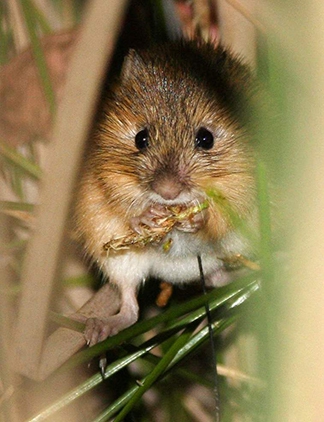New Mexico Meadow Jumping Mouse
In 1983, New Mexico State listed the New Mexico Meadow Jumping Mouse (NMMJM) as threatened. The state status of the species was uplisted to endangered in 2006. In 2014, the NMMJM was federally listed as endangered by the U.S. Fish and Wildlife Service.
-
Scientific Name: Zapus hudsonius luteus
-
Species Abbreviation: NMMJM
-
Status:
Federally Endangered Species;
New Mexico State Endangered Species,
New Mexico Species of Greatest Conservation Need
- Documents
-
View documents from the Program Library.
See All documents

Photo Credit: U.S. Fish and Wildlife Service
- New Mexico Department of Game and Fish Wildlife Notes
- New Mexico Game and Fish Threatened and Endangered Species of New Mexico 2018 Biennial Review
- U.S. Fish and Wildlife Service Environmental Conservation Online System
- U.S. Fish and Wildlife Service New Mexico Meadow Jumping Mouse
- U.S. Fish and Wildlife Service Species Status Assessment Report for the New Mexico Meadow Jumping Mouse
- Biota Information System of New Mexico (BISON-M)
Description
The NMMJM is a subspecies of the meadow jumping mouse (Zapus hudsonius), which is a member of a family found in the northern hemisphere. The NMMJM grows to about 7.1-9.2 inches in total length and has elongated feet (7 .2 inches), a long, two-toned tail (4.9 inches), a dark yellowish-brown, dark brown, and grayish-brown back, yellowish-brown sides, and a white underbody. The meadow jumping mouse can be distinguished from mice of other families by its long hind legs, long tail, and two-footed jumping gait. In areas where NMMJM occurrence overlaps with that of the Western jumping mouse, the NMMJM can be differentiated by its fur characteristics, the absence of white ear fringe, and its teeth arrangement, as well as its body measurements, including mass, tail length, and right hind foot length.
The NMMJM has a limited active period that lasts mainly through the summer, when food resources like forbs, grasses, and sedge seeds are more readily available. This active period is typically from about late May/early June to late September/early October in high elevation areas and from mid-May to late October in low elevation areas. Breeding occurs in July or August and the NMMJM likely only produces one litter (2-7 young) each year. The NMMJM depends on tall, dense riparian herbaceous vegetation for the food resources and shelter necessary to successfully birth and rear their pups. Later in the active period, this vegetation cover and food resources are vital for the NMMJM to accumulate the fat reserves necessary for survival during the 8–9-month hibernation period, which extends from September or October to the following May or June.
Distribution
It is difficult to determine the historical range of the NMMJM as the subspecies occurs at low population densities and is rarely or unpredictably encountered. The best available summary of historical NMMJM locations identifies populations in riparian and wetland areas along the Sangre de Cristo Mountains in Colorado and New Mexico, the San Juan Mountains in southern Colorado, the Jemez and Sacramento mountains in central and southern New Mexico, the Rio Grande Valley from Espanola to Bosque del Apache NWR in central New Mexico, and the White Mountains in eastern Arizona. Currently, the NMMJM has a range of eight geographic management areas that are defined by current critical habitat units and the distribution of 77 populations. These areas are in Utah, Colorado, Arizona, and New Mexico, which indicates current distribution of the NMMJM throughout its historical range.
Recovery Efforts
The main limiting factor of the NMMJM is loss of suitable habitat resulting from such threats as cattle overgrazing and limited water availability necessary to support required habitats, as well as wildfire and road construction. Recovery of the subspecies requires conservation and restoration of suitable and connected riparian habitats within each of the eight geographic management areas to promote population increases and expansion. Recovery efforts also depend on developing and implementing sustainable grazing and water management practices. In 2020, the MRGESCP included recovery of the NMMJM in its long-term goals.
